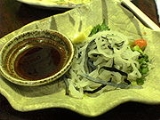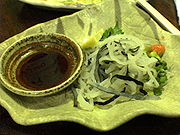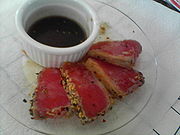
Ponzu
Encyclopedia

Citrus
Citrus is a common term and genus of flowering plants in the rue family, Rutaceae. Citrus is believed to have originated in the part of Southeast Asia bordered by Northeastern India, Myanmar and the Yunnan province of China...
-based sauce commonly used in Japanese cuisine
Japanese cuisine
Japanese cuisine has developed over the centuries as a result of many political and social changes throughout Japan. The cuisine eventually changed with the advent of the Medieval age which ushered in a shedding of elitism with the age of shogun rule...
. It is tart, with a thin, watery consistency and a light yellow color. Ponzu shōyu or ponzu jōyu (ポン酢醤油) is ponzu sauce with soy sauce
Soy sauce
Soy sauce is a condiment produced by fermenting soybeans with Aspergillus oryzae or Aspergillus sojae molds, along with water and salt...
(shōyu) added, and the mixed product is widely referred to as simply ponzu.
The element pon arrived in the Japanese language
Japanese language
is a language spoken by over 130 million people in Japan and in Japanese emigrant communities. It is a member of the Japonic language family, which has a number of proposed relationships with other languages, none of which has gained wide acceptance among historical linguists .Japanese is an...
from the Dutch
Dutch language
Dutch is a West Germanic language and the native language of the majority of the population of the Netherlands, Belgium, and Suriname, the three member states of the Dutch Language Union. Most speakers live in the European Union, where it is a first language for about 23 million and a second...
word pons (which in turn is derived from and shares the meaning of the English
English language
English is a West Germanic language that arose in the Anglo-Saxon kingdoms of England and spread into what was to become south-east Scotland under the influence of the Anglian medieval kingdom of Northumbria...
word punch
Punch (drink)
Punch is the term for a wide assortment of drinks, both non-alcoholic and alcoholic, generally containing fruit or fruit juice. The drink was introduced from India to England in the early seventeenth century; from there its use spread to other countries...
). is Japanese for vinegar, and hence the name literally means "pon vinegar".
Ponzu is made by simmering mirin
Mirin
is an essential condiment used in Japanese cuisine, consisting of 40%–50% sugar. It is a kind of rice wine similar to sake, but with a lower alcohol content—14% instead of 20%. There are three general types. The first is hon mirin , which contains alcohol. The second is shio mirin, which contains...
, rice vinegar
Vinegar
Vinegar is a liquid substance consisting mainly of acetic acid and water, the acetic acid being produced through the fermentation of ethanol by acetic acid bacteria. Commercial vinegar is produced either by fast or slow fermentation processes. Slow methods generally are used with traditional...
, katsuobushi
Katsuobushi
is the Japanese name for dried, fermented, and smoked skipjack tuna .Shaved Katsuobushi and dried kelp - kombu - are the main ingredients of dashi, a broth that forms the basis of many soups and sauces in Japanese cuisine.Katsuobushi's distinct umami flavor comes from its high...
flakes, and seaweed
Seaweed
Seaweed is a loose, colloquial term encompassing macroscopic, multicellular, benthic marine algae. The term includes some members of the red, brown and green algae...
(konbu) over medium heat. The liquid is then cooled, strained to remove the katsuobushi flakes, and finally the juice of one or more of the following citrus fruits is added: yuzu
Yuzu
The yuzu is a citrus fruit and plant originating in East Asia. It is believed to be a hybrid of sour mandarin and Ichang papeda...
, sudachi
Sudachi
Sudachi is a small, round, green citrus fruit which belongs to the papeda subgroup of citrus plants....
, daidai
Daidai
The daidai , is an Asian variety of bitter orange. The name daidai, originally meaning several generations, originates from the fruit staying on the tree for several years if not picked. The colour of the fruit returns to green in the spring.The daidai originated in the Himalayas...
, kabosu
Kabosu
is a juicy green citrus fruit closely related to the yuzu with the sharpness of lemon, used instead of vinegar in some Japanese dishes. It grows on a flowering plant with sharp thorns, and the fruit is harvested when still green but ripens to yellow...
, or lemon
Lemon
The lemon is both a small evergreen tree native to Asia, and the tree's ellipsoidal yellow fruit. The fruit is used for culinary and non-culinary purposes throughout the world – primarily for its juice, though the pulp and rind are also used, mainly in cooking and baking...
.
Commercial ponzu is generally sold in glass bottles, which may have some sediment
Sediment
Sediment is naturally occurring material that is broken down by processes of weathering and erosion, and is subsequently transported by the action of fluids such as wind, water, or ice, and/or by the force of gravity acting on the particle itself....
.

Tataki
Tataki , also called tosa-mi, is a manner of preparing fish or meat in Japanese cuisine. The meat or fish is seared very briefly over a hot flame or pan, briefly marinated in vinegar, sliced thinly and seasoned with ginger .The method originated in Tosa Province, now part of...
(lightly grilled, then chopped meat or fish), and also as a dip for nabemono
Nabemono
Nabemono or simply called nabe, is a term referring to all varieties of Japanese steamboat dishes, also known as one pot dishes....
(one pot dishes) such as shabu shabu. It is used as a dip for sashimi. In the Kansai
Kansai
The or the lies in the southern-central region of Japan's main island Honshū. The region includes the prefectures of Mie, Nara, Wakayama, Kyoto, Osaka, Hyōgo, and Shiga. Depending on who makes the distinction, Fukui, Tokushima and even Tottori Prefecture are also included...
region, it is offered as a topping for takoyaki
Takoyaki
is a popular ball-shaped Japanese dumpling or more like a savory pancake made of batter and cooked in a special takoyaki pan...
.

